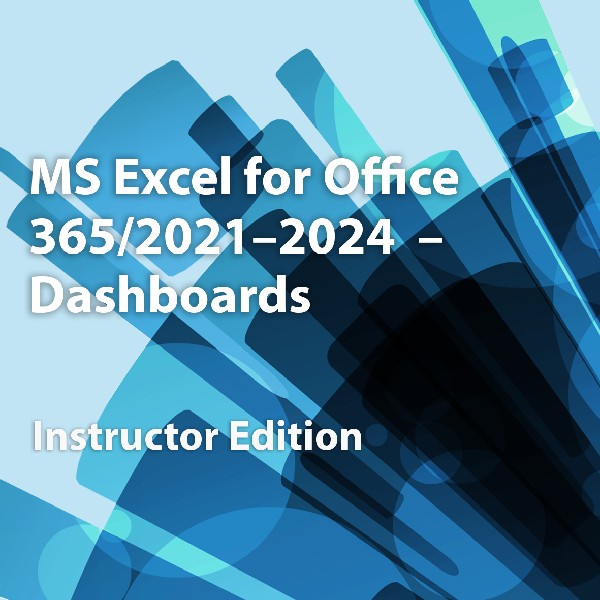
MS Excel for Office 365/2019-2024-Dashboards, Instructor Edition
Microsoft Excel for Office 365/2019-2024: Dashboards
Course Specifications
Course Number: ELK91–151_rev1.2
Course Length: 1 day
Course Description
Today's world runs on data more than ever before and that's a trend not likely to change, or even slow down, any time soon. With the tremendous amount of available data, the ability to make sense of it continues to be an ongoing challenge. You already know how to use Excel to perform simple calculations and modify worksheets to make them easier to read, interpret, and present to others. But Excel is capable of doing so much more.
To gain a truly competitive edge, you need to be able to extract actionable organizational intelligence from your raw data, and present it in a visually compelling format that enables decision makers to view key trends and gain insights. And that's exactly what this course aims to help you do.
This course builds upon the foundational knowledge presented in the Microsoft® Excel® for Office 365™ (Desktop or Online): Part 1 course and introduces the basics of data analysis and how to use Excel to create informative dashboards.
Course Objective: In this course, you will analyze and visualize data using Microsoft Excel and associated tools.
You will:
- Perform data analysis fundamentals.
- Visualize data with Excel.
- Analyze data with formulas and functions.
- Analyze data with PivotTables.
- Present visual insights with dashboards in Excel.
Target Student: This course is designed for students who already have foundational knowledge and skills in Excel and who wish to begin taking advantage of the data analysis functionality with Microsoft Excel by using functions, charts, and PivotTables, and using visualizations in charts and dashboards in Excel.
Prerequisites: To ensure success, you should have baseline skill using Microsoft Excel worksheets, particularly in creating workbooks with formulas and functions. You can obtain this level of knowledge and skill by taking the following or any similar equivalent Logical Operations course:
- Microsoft® Excel® for Office 365™ (Desktop or Online): Part 1
Additional workplace experience with Excel is highly recommended.
Hardware Requirements
For this course, you will need one computer for each student and one for the instructor. Each computer will need the following minimum hardware configurations:
- 1 gigahertz (GHz) 64-bit (x64) processor.
- 4 gigabytes (GB) of Random Access Memory (RAM).
- 32 GB available storage space.
- Monitor capable of a screen resolution of at least 1,024 × 768 pixels, at least a 256-color display, and a video adapter with at least 4 MB of memory.
- Bootable DVD-ROM or USB drive.
- Keyboard and mouse or a compatible pointing device.
- Fast Ethernet (100 Mb/s) adapter or faster and cabling to connect to the classroom network.
- IP addresses that do not conflict with other portions of your network.
- Internet access (contact your local network administrator).
- (Instructor computer only) A display system to project the instructor's computer screen.
Software Requirements
- Microsoft® Office Professional Plus 2019 or Office 365™
- Microsoft® Windows® 10 Professional or Enterprise
Course Content
Lesson 1: Data Analysis Fundamentals
Lesson 2: Visualizing Data with Excel
Lesson 3: Analyzing Data with Formulas and Functions
Lesson 4: Analyzing Data with PivotTables
Lesson 5: Presenting Visual Insights with Dashboards in Excel
